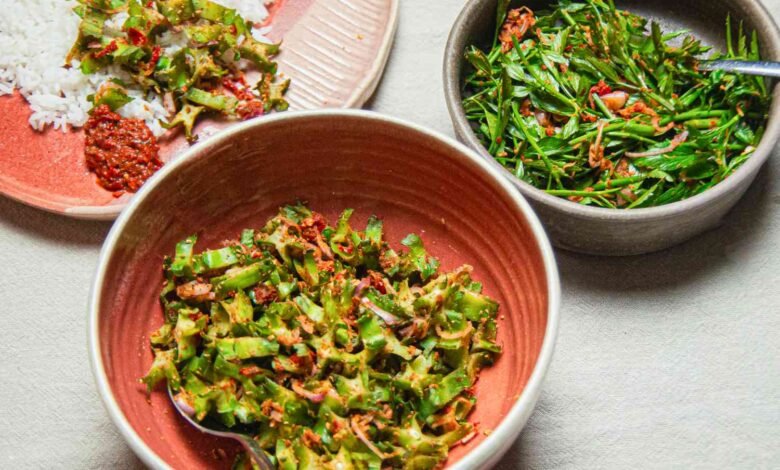

Why It Works
- Toasted grated coconut adds smoky-sweet appeal to final salad.
- Using readily available desiccated coconut significantly reduces the cooking time.
- Blanching some types of vegetables while leaving others raw ensures the best characteristics of each are highlighted.
A significant part of Malay culinary tradition is “ulam,” which refers to wild or cultivated vegetables that are eaten raw or briefly blanched as an accompaniment to the rest of the dishes of a meal. Almost any vegetable can be used as an ulam as long as it is edible raw. An extension of the ulam concept is “kerabu,” which is basically the Malay word for “salad.” The aforementioned ulam are combined and dressed with sambal (usually sambal belacan, which includes shrimp paste along with red chiles and lime juice) and toasted grated coconut, and then perked up with lime juice to make a fresh and spicy salad. Kerabu can be seen as one part of a larger vegetable-focused theme across Southeast Asia, from the fresh som tam, or “pounded salads,” of Thailand to the cooked urap salads of Indonesia, all of them no doubt influencing each other in taste and texture.
Serious Eats /Michelle Yip
Much like Western-style salads, kerabu tends to be based on a star ingredient. While you can find kerabu featuring meat like beef lungs, chicken feet, or jellyfish throughout Malaysia, it’s much more common to see kerabu based on vegetables, both raw and blanched. Multiple vegetables are sometimes found in one kerabu, but it’s more common for each kerabu to feature a single main ingredient. Popular choices for the main component of vegetable kerabu include crunchy green pods like long beans, green beans, or, my personal favorite, winged beans (kacang botor). Leafy vegetables are common, too, particularly hardy and mild-flavored greens like water celery (daun selom or, in Korean, minari, as featured in the eponymous 2020 film) or edible varieties of pennywort. These leafy greens tend to be wild weeds, gathered as part of a delicious, cheap, and nutritious meal.
An important ingredient in kerabu is kerisik, or toasted grated coconut; it adds a smoky-sweet flavor and pleasant chew to the salad. To make it, you dry-fry the coconut in a pan for roughly an hour until it reaches the desired level of toastiness: Blond kerisik is the shade a piece of lightly toasted bread and retains some fresh coconut flavor; dark kerisik is more deeply smoky and caramelized. While fresh grated coconut is preferable, as it has more of its flavorful essential oils intact, I’ve discovered in the process of developing this recipe that using shelf-stable desiccated coconut can cut the cooking time for kerisik by half. That, plus the availability of desiccated coconut over fresh grated coconut, makes it a worthy option.
Serious Eats / Michelle Yip
Blonde kerisik is faster to make and plays well with leafy versions of kerabu. When kerisik gets to a very dark stage, it’s dried out enough that it can last for up to a month in the fridge. Folks usually make kerisik like this in bulk, so it’s ready to add to kerabu, gulai, rendang, and other dishes that benefit from a smoky coconutty hit. In a well-stocked Malay kitchen, sambal belacan and kerisik are almost always on hand in the fridge. This means that kerabu can be pulled together in as little as 10 minutes, making it an easy weeknight win.
A new favorite dinner party idea of mine is to set up a kerabu bar, where guests can choose what goes into their individual kerabu. I like to set out different fresh and blanched greens, along with kerisik and sambal belacan, plus a mixing bowl at the table for folks to mix their individual kerabu. Fried or grilled proteins like fish and tofu are great to serve with the kerabu, as is a pot of cooked rice to eat with it.
Source link



